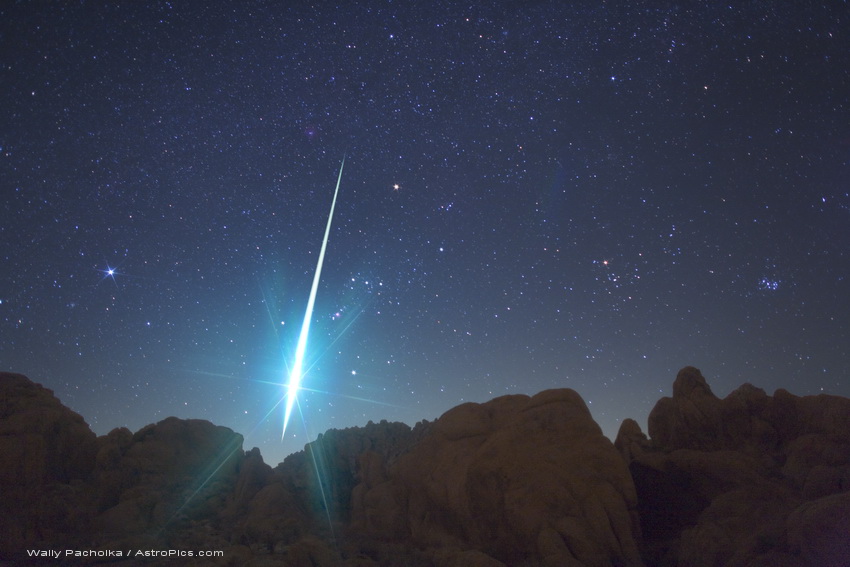NASA Science News | 06 Dec 2010
Activity in Geminid Parent (3200) Phaethon - David Jewitt, Jing LiThe Geminid meteor shower, which peaks this year on Dec. 13th and 14th, is the most intense meteor shower of the year. It lasts for days, is rich in fireballs, and can be seen from almost any point on Earth.
- A Geminid fireball explodes over the Mojave Desert in 2009. [i](Credit: [url=http://www.astropics.com/about1.html]Wally Pacholka[/url]/[url=http://www.astropics.com/geminid-meteor-fireball-9095.html]AstroPics.com[/url]/[url=http://www.twanight.org/newTWAN/photos.asp?ID=3002292]TWAN[/url]/[url=http://apod.nasa.gov/apod/ap091217.html]APOD[/url])[/i]
...
Most meteor showers come from comets, which spew ample meteoroids for a night of 'shooting stars.' The Geminids are different. The parent is not a comet but a weird rocky object named 3200 Phaethon that sheds very little dusty debris—not nearly enough to explain the Geminids.
...
3200 Phaethon was discovered in 1983 by NASA's IRAS satellite and promptly classified as an asteroid. What else could it be? It did not have a tail; its orbit intersected the main asteroid belt; and its colors strongly resembled that of other asteroids. Indeed, 3200 Phaethon resembles main belt asteroid Pallas so much, it might be a 5-kilometer chip off that 544 km block.
...
Researchers have looked carefully at the orbits of Geminid meteoroids and concluded that they were ejected from 3200 Phaethon when Phaethon was close to the sun—not when it was out in the asteroid belt breaking up with Pallas. The eccentric orbit of 3200 Phaethon brings it well inside the orbit of Mercury every 1.4 years. The rocky body thus receives a regular blast of solar heating that might boil jets of dust into the Geminid stream.
...
To test the hypothesis, researchers turned to NASA's twin STEREO spacecraft, which are designed to study solar activity. Coronagraphs onboard STEREO can detect sungrazing asteroids and comets, and in June 2009 they detected 3200 Phaethon only 15 solar diameters from the sun's surface.
...
Jewett and Li's "rock comet" hypothesis is compelling, but they point out a problem: The amount of dust 3200 Phaethon ejected during its 2009 sun-encounter added a mere 0.01% to the mass of the Geminid debris stream—not nearly enough to keep the stream replenished over time. Perhaps the rock comet was more active in the past?
...
This month Earth will pass through the Geminid debris stream, producing as many as 120 meteors per hour over dark-sky sites. The best time to look is probably between local midnight and sunrise on Tuesday, Dec. 14th, when the Moon is low and the constellation Gemini is high overhead, spitting bright Geminids across a sparkling starry sky.
- Astronomical Journal 140(5) 1519 (15 Oct 2010) DOI: 10.1088/0004-6256/140/5/1519
arXiv.org > astro-ph > arXiv:1009.2710 > 14 Sep 2010

